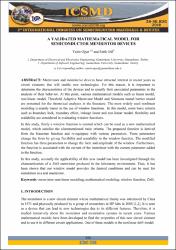A VALIDATED MATHEMATICAL MODEL FOR SEMICONDUCTOR MEMRISTOR DEVICES

Göster/
Erişim
info:eu-repo/semantics/openAccessTarih
2018-08Erişim
info:eu-repo/semantics/openAccessÜst veri
Tüm öğe kaydını gösterÖzet
Memristors and memristive devices have attracted interest in recent years as circuit elements that will enable new technologies. For this reason, it is important to determine the characteristics of the devices and to specify their associated parameters in the analysis of their behavior. At this point, various mathematical models such as linear model, non-linear model, Threshold Adaptive Memristor Model and Simmons tunnel barrier model are presented for the theoretical analyzes in the literature. The most widely used nonlinear modeling is mainly based on the use of window functions. In this model, some basic criteria such as boundary lock, boundary effect, linkage linear and non-linear model, flexibility and scalability are considered in evaluating window functions. In this study, firstly a window function is created which can be used as a new mathematical model, which satisfies the aforementioned basic criteria. The proposed function is derived from the Gaussian function and re-equipped with various parameters. These parameters change the form by giving flexibility and scalability to the window function. The modified function has three parameters to change the form and amplitude of the window. Furthermore, the function is associated with the current of the memristor with the current parameter added to the function. In this study, secondly the applicability of this new model has been investigated through the characterization of a ZnO memristor produced in the laboratory environment. Thus, it has been shown that our window model provides the desired conditions and can be used for simulation in a real memristor.

















